

Invitation.
Some months ago, I ask Enid if I can come for the day to help in her apiary. I need to get some more practical experience working with someone managing a lot more colonies than I do before I sit the exams for National Diploma in Beekeeping certificate (sometime in the future). Enid generously invites me to stay for 3 nights in early July.
The Doyenne of Scottish Beekeeping.
Enid invites Margaret Thomas, NDB, to come and put me through my paces and offer tips for improving my skills. Margaret is one of the most respected beekeepers in the UK. The famous Ted Hooper was her mentor. How lucky am I!
Enid.
Enid has been keeping bees for a quarter of a century and manages around 50 colonies. She is involved at SBA (Scottish Beekeeper’s Association level) and is one of the trustees with a remit for publicity and shows. Enid is an assessor for the SBA practical beekeeping exams and mentors local beekeepers also. Her phone has a cuckoo call announcing incoming messages. I could be forgiven for thinking that it is still spring for that cuckoo never lets up. Not only does Enid spend a week at the Royal Highland Show each year, she is responsible for organising this year’s Apimondia honey show in Montreal. Enid receives a continuous stream of Apimondia-related questions I appreciate even more her hospitality, and fitting in my agenda to her busy life.
First Apiary.
It’s a hot day and I’ve forgotten my water bottle, but luckily we’re in a walled garden with a tap nearby. Enid uses Smith hives with short lugs and top bee space which requires slightly different frame handling skills. I’m impressed by her double brood box system of 7 deep frames in each box flanked by home-made dummy boards of 2-frames-width. Like Margaret Forrest, Enid has wood working skills. The top brood box is so much easier to lift off with only 7 frames, and the bees can chimney the brood nest more like how they would in the wild.
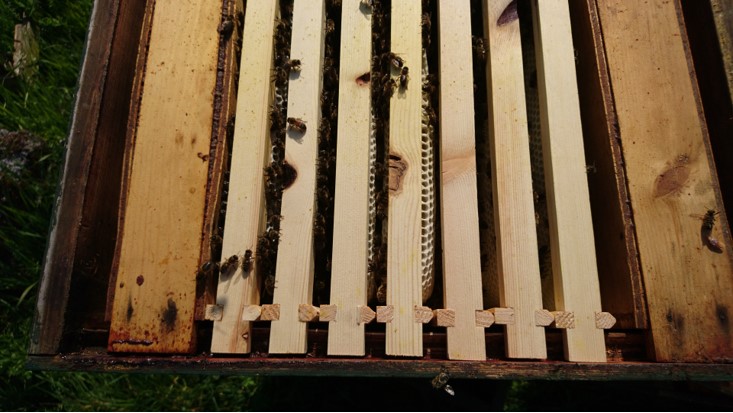
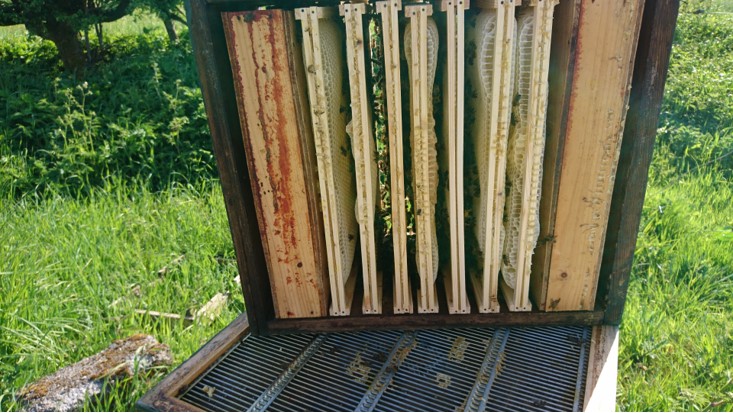
Speeding Up.
Bee farmers have to work quickly and think on their feet. They don’t have the luxury of a leisurely inspection and decision making over a nice cup of tea. I’m behind the curve on this first apiary and need to ratchet up a gear or 2. We have another large apiary to visit in the afternoon. However, 15 colony inspections later and it’s lunchtime. Phew!
Poor Weather–Poor Queen Mating.
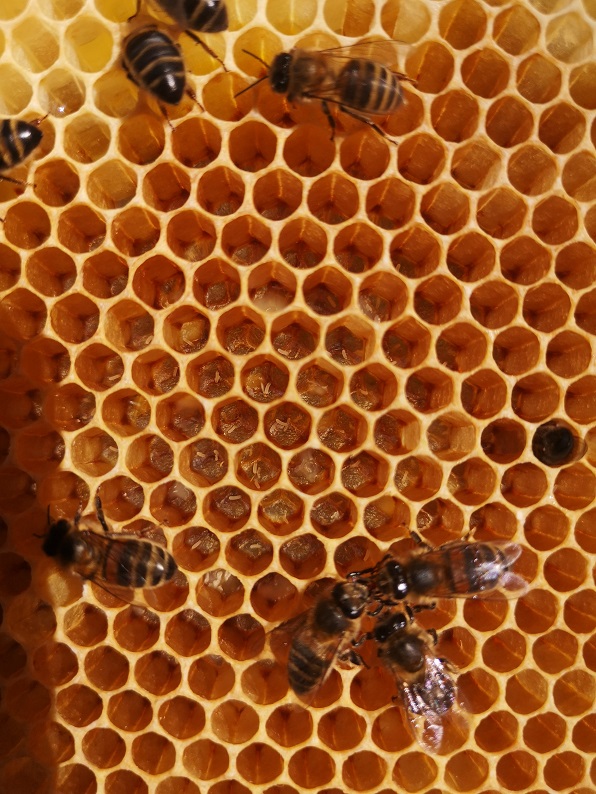
The recent bad weather Scotland-wide has impacted on this first apiary and 2 colonies have laying workers. We remove the brood boxes as far away as possible and shake bees out hoping that the laying workers will not return to the original hive site which now has a hive, with a queen from another colony that needs boosting, near it.
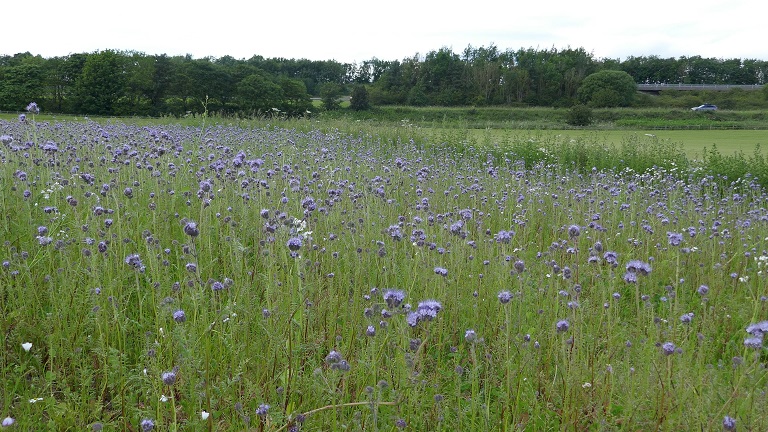
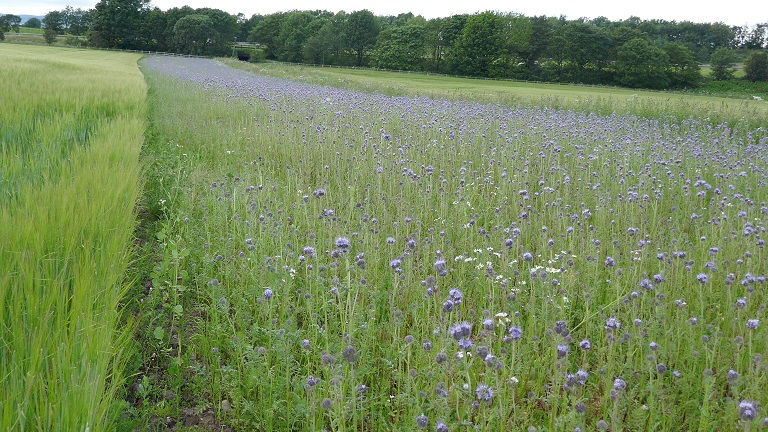

Afternoon Apiary.
This apiary is near large swathes of phacelia which is one of the best plants for bees in terms of crude protein levels and nectar but it needs to be warm enough to produce the nectar. The pollen is delphinium blue. Enid has hopes of getting a crop of mono-floral honey from this apiary. It is just starting to pick up but the supers are light and most of the 15 colonies have fondant in place. A few of the colonies are waiting for their queens to start laying. This is the same for 2 of my own home apiary colonies. We all hope for better weather for the rest of the short summer.
Day 2.
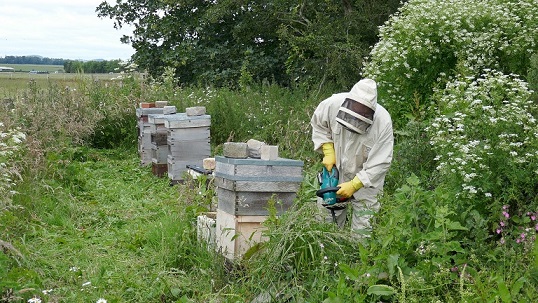
St Andrews.
Margaret leaves on the second day as Enid and I head over to St Andrews to help a friend and check on her local association colonies. I’m getting slicker and we have time to inspect both apiaries before a delicious lunch in our host’s St Andrews’s home. The house has a front door opening onto a main street with a surprisingly long and spacious garden at the back filled with beautiful shrubs and flowers.
Last Apiary.
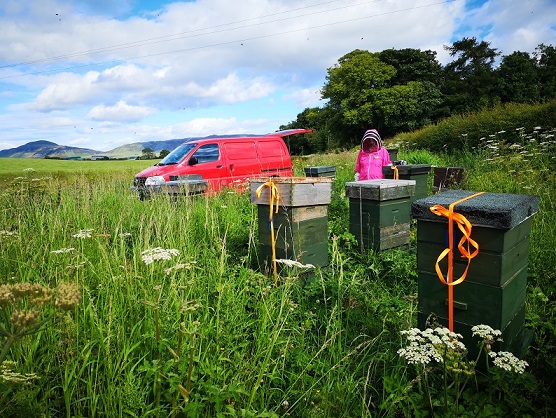
This apiary is doing well and a couple of colonies need another super so it’s looking good here. I’m on a roll and I get this apiary inspected in bee- farmer- time. Enid is pleased because all her 51 colonies (a handful of nucs included) have been checked over (by me) in the last couple of days. I’m happy but I feel like I’ve been in the gym since I arrived. Enid drives into the nearest village and buys us both enormous tubs of the best ice cream that I’ve tasted in ages.
Jerry.
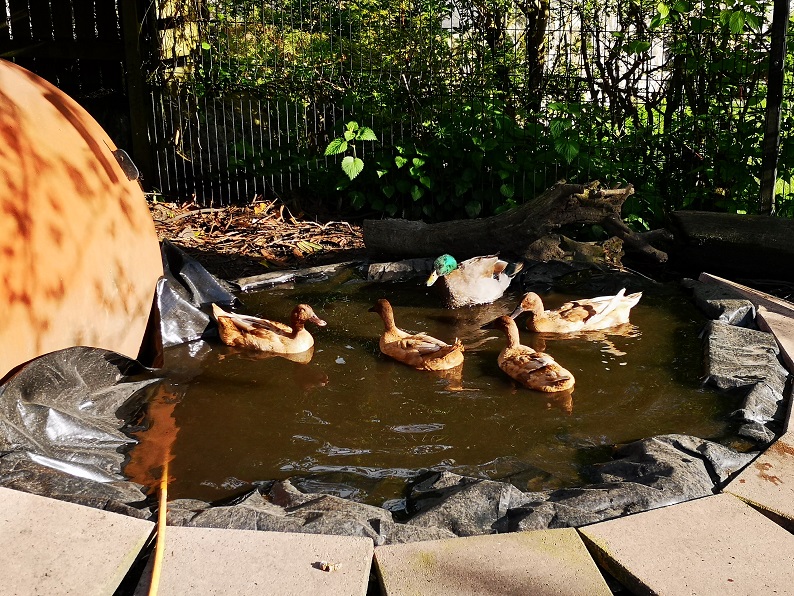
Avian Pets.
I can’t finish this blog without mentioning Jerry, the Khaki Campbell duck. Enid has done what I’ve always wanted to do which is to watch a goose or duck hatch and have them imprint on me to form a bond. Jerry started off in an egg incubator in Enid’s kitchen and, although she missed his moment of hatching, she got home soon after and Jerry is forever besotted by her. As a treat, he is allowed to come out of the run and follow her round the garden where he picks up delicious slugs. The girls produce eggs alongside Enid’s flock of hens who live in luxury at the bottom of the garden.

Fascinating Ann. What was the hedge trimmer used for?
Cutting away vegetation from around the hives.
It’s great to hear how bee farmers can work through so many hives in a short time. It sounds like a lot of hard work!
Enid wrote a very good article in The Scottish Beekeeper (January 2016 issue) about the wide dummies she uses. I had recently started my woodcraft class then and so had a go at making some wide dummies for my own hives. They work a treat and when I’ve use these in a hive I can remove the dummy and then have enough space to work through the colony without the need to place a brood frame on the outside.